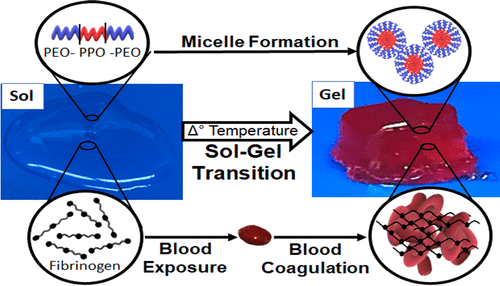当前位置:
X-MOL 学术
›
ACS Appl. Bio Mater.
›
论文详情
Our official English website, www.x-mol.net, welcomes your
feedback! (Note: you will need to create a separate account there.)
Evaluation of Viscoelastic Properties, Blood Coagulation, and Cellular Responses of a Temperature-Sensitive Gel for Hemostatic Application
ACS Applied Bio Materials ( IF 4.6 ) Pub Date : 2020-04-07 , DOI: 10.1021/acsabm.0c00160 Joseph Jun 1 , Reid C Millican 2 , Jennifer A Sherwood 2 , Bernabe S Tucker 3 , Vineeth M Vijayan 3, 4 , Grant C Alexander 2 , Vinoy Thomas 3, 4 , Brigitta C Brott 5 , Patrick T J Hwang 2
ACS Applied Bio Materials ( IF 4.6 ) Pub Date : 2020-04-07 , DOI: 10.1021/acsabm.0c00160 Joseph Jun 1 , Reid C Millican 2 , Jennifer A Sherwood 2 , Bernabe S Tucker 3 , Vineeth M Vijayan 3, 4 , Grant C Alexander 2 , Vinoy Thomas 3, 4 , Brigitta C Brott 5 , Patrick T J Hwang 2
Affiliation

|
Hemorrhagic blood loss from traumatic injury is the leading cause of death in severe accidents and combat injuries. Treating and stopping blood loss in a timely and effective manner is essential for the survival of the patient. Currently, QuikClot and dry fibrin sealant dressing are well-known approaches for hemostatic treatment. However, these dressings have limitations in slowing blood loss such as being brittle, low blood absorption, and a poor sealant of the injury site. Temperature-sensitive gels may have potential as a platform for delivery of coagulation factors to improve hemostasis and wound sealing in the treatment of traumatic injuries. Here, we developed a temperature-sensitive triblock copolymer (poly ethylene oxide (PEO)-poly propylene oxide (PPO)-poly ethylene oxide (PEO)) containing fibrinogen to promote blood coagulation through gel formation at body temperature. This temperature sensitive solution-to-gel (sol–gel) transition does not require cross-linking agents or UV photoinitiation. We determined that 22 wt % (weight percent) copolymers with and without fibrinogen was the maximum concentration for sol–gel transition at body temperature. Rheology results further confirmed this sol–gel transition of 22 wt % copolymers at body temperature. We showed that fibrinogen itself promoted blood coagulation. Additionally, 22 wt % copolymer with fibrinogen successfully demonstrated stable blood coagulation within the gel compared to 22 wt % copolymer without fibrinogen. Twenty-two weight percent copolymers with and without fibrinogen also exhibited excellent biocompatibility based on cell viability, proliferation, and morphology analysis. In addition, treatment of 22 wt % copolymers did not stimulate pro-inflammatory TNF-α production from differentiated human monocytes. Our results suggest that 22 wt % of a temperature-sensitive copolymer gel containing fibrinogen has great potential as a hemostatic agent stimulating coagulation and providing immediate wound coverage for protection through a sol–gel transition at body temperature.
中文翻译:

用于止血应用的温度敏感凝胶的粘弹性、血液凝固和细胞反应的评估
外伤造成的失血是严重事故和战斗伤害中死亡的主要原因。及时有效地治疗和止血对于患者的生存至关重要。目前,QuikClot 和干纤维蛋白密封剂敷料是众所周知的止血治疗方法。然而,这些敷料在减缓失血方面存在局限性,例如易碎、血液吸收率低和损伤部位的密封性差。温度敏感凝胶可能具有作为凝血因子输送平台的潜力,以改善创伤治疗中的止血和伤口封闭。这里,我们开发了一种温度敏感的三嵌段共聚物(聚环氧乙烷 (PEO)-聚环氧丙烷 (PPO)-聚环氧乙烷 (PEO)),其中含有纤维蛋白原,可通过在体温下形成凝胶来促进血液凝固。这种对温度敏感的溶液到凝胶(溶胶-凝胶)的转变不需要交联剂或紫外光引发。我们确定含有和不含纤维蛋白原的 22 wt%(重量百分比)共聚物是体温下溶胶-凝胶转变的最大浓度。流变学结果进一步证实了 22 wt% 共聚物在体温下的溶胶-凝胶转变。我们发现纤维蛋白原本身促进血液凝固。此外,与不含纤维蛋白原的 22 重量%共聚物相比,含纤维蛋白原的 22 重量%共聚物成功地证明了凝胶内稳定的血液凝固。根据细胞活力、增殖和形态分析,含有和不含纤维蛋白原的 22% 重量的共聚物也表现出优异的生物相容性。此外,处理 22 wt% 的共聚物不会刺激分化的人单核细胞产生促炎 TNF-α。我们的研究结果表明,22 wt% 的含有纤维蛋白原的温度敏感共聚物凝胶具有作为止血剂的巨大潜力,可刺激凝血并通过体温下的溶胶-凝胶转变提供即时伤口覆盖保护。
更新日期:2020-04-07
中文翻译:

用于止血应用的温度敏感凝胶的粘弹性、血液凝固和细胞反应的评估
外伤造成的失血是严重事故和战斗伤害中死亡的主要原因。及时有效地治疗和止血对于患者的生存至关重要。目前,QuikClot 和干纤维蛋白密封剂敷料是众所周知的止血治疗方法。然而,这些敷料在减缓失血方面存在局限性,例如易碎、血液吸收率低和损伤部位的密封性差。温度敏感凝胶可能具有作为凝血因子输送平台的潜力,以改善创伤治疗中的止血和伤口封闭。这里,我们开发了一种温度敏感的三嵌段共聚物(聚环氧乙烷 (PEO)-聚环氧丙烷 (PPO)-聚环氧乙烷 (PEO)),其中含有纤维蛋白原,可通过在体温下形成凝胶来促进血液凝固。这种对温度敏感的溶液到凝胶(溶胶-凝胶)的转变不需要交联剂或紫外光引发。我们确定含有和不含纤维蛋白原的 22 wt%(重量百分比)共聚物是体温下溶胶-凝胶转变的最大浓度。流变学结果进一步证实了 22 wt% 共聚物在体温下的溶胶-凝胶转变。我们发现纤维蛋白原本身促进血液凝固。此外,与不含纤维蛋白原的 22 重量%共聚物相比,含纤维蛋白原的 22 重量%共聚物成功地证明了凝胶内稳定的血液凝固。根据细胞活力、增殖和形态分析,含有和不含纤维蛋白原的 22% 重量的共聚物也表现出优异的生物相容性。此外,处理 22 wt% 的共聚物不会刺激分化的人单核细胞产生促炎 TNF-α。我们的研究结果表明,22 wt% 的含有纤维蛋白原的温度敏感共聚物凝胶具有作为止血剂的巨大潜力,可刺激凝血并通过体温下的溶胶-凝胶转变提供即时伤口覆盖保护。











































 京公网安备 11010802027423号
京公网安备 11010802027423号